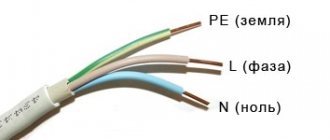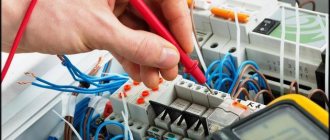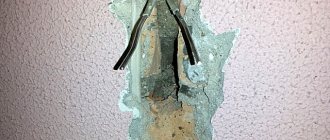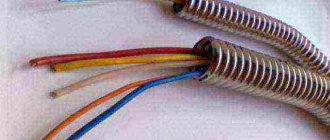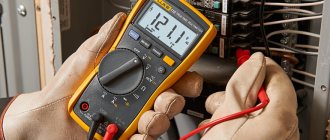Hidden wiring has a lot of advantages, but there is also one important disadvantage - in the event of a faulty electrical wiring, redevelopment and lack of an electrification plan, it is extremely difficult to find the desired area under the interior decoration. Let's figure out how to find wiring in the wall to eliminate the possibility of damage. There are many effective ways to determine electrical wiring in a room, and to choose the appropriate option, let’s take a closer look at them.
Detection of hidden wiring using a special device Source googleusercontent.com
Advantages of hidden installation and why you need to know where the wires go
When planning a home renovation or redevelopment, the question often arises of how to find hidden wiring in the wall. External wiring in homes was made before, but now it is rarely used, mainly as an element of a design solution, when the wires are simply attached to the wall.
This is what modern external wiring looks like Source yandex.net
The method of external wiring was abandoned and hidden installation was preferred because of its safety and aesthetics, when the cables are laid in grooves and then covered with putty. During repair work, you have to drill into the walls and in order not to damage the electrical wiring, you need to know its location.
Information about electrification is necessary in the following situations:
- redevelopment of the entire electrical wiring diagram;
- partial replacement of electrics;
- redevelopment of the home itself;
- emergency situations;
- design change.
If the task is to completely replace the electrical wiring, then you can ignore the location of the old wires. However, you still need to make sure that the new and old wiring do not intersect.
Using a hearing aid
Practical and effective ways to find electrical wiring in the wall
It is absolutely impossible to be negligent in searching for wiring or neglecting the exact location of electrical wires, so as not to face serious consequences.
Based on SNiP and PUE, there are a number of rules and requirements for the installation of electrical wiring in a room. According to these requirements, wires from the junction box must be laid in different directions, but only vertically or horizontally, and in no case diagonally, and the angle of rotation must be 90 degrees. If you are sure that the electrical installation meets all the requirements and, knowing this principle, it will be easier to find hidden wiring.
Correct grooves for electrical wiring Source kabanchik.by
But electrical wiring is not always laid by specialized specialists who make grooves strictly vertically or horizontally. Very often, such work is carried out by finishers who are not specialists in the field of electrical engineering and who do not care how the owner of the premises will drill into the walls in the future and so that he does not bump into a cable. Opening up a wall, making indentations in it and then restoring the cable is not a very pleasant task and is quite expensive.
There are several simple ways to find wiring in a wall without a device:
- Visual inspection.
This method is good when the walls are without wallpaper and you can get to the plaster. Then carefully inspect the walls for unevenness or differences in the color of the plaster.
Since during hidden wiring the wires are laid in grooves and then covered over, these areas may have unevenness and can be detected by running your hand or carefully inspecting the wall. Having found a place, carefully beat off the plaster with a plumber's hammer along the entire groove.
If it is possible to remove the exterior finish, the grooves will be visible to the naked eye Source fishkielektrika.ru
- Search by radio receiver.
The method is not accurate enough (within 10 cm), but it is proven and works. Turn on the radio, tune it to a frequency of 100 kHz and bring it to the wall. Carefully move along the length without touching the surface until the noise increases and a cracking sound appears.
The closer the communication lines, the clearer and stronger the sounds become. Such signals and changes in tone will indicate the presence of wiring. If the radio has an antenna, then its end must be moved along the surface. To use this method, several conditions must be met: the room must be quiet and the wire must be live.
You can use such a radio receiver Source sankt-peterburg.sidex.ru
- Search using a hearing aid.
You need to find older brands of hearing aids. The method is quite accurate and consists of the following: set the device to the “telephone” function, then it responds to electromagnetic vibrations. Bring the device to the intended wiring location and listen until characteristic sounds appear.
- Using a multimeter.
For this method you need a multimeter and a transistor. The first one is turned on for the function of determining a resistance of 200 kOhm, connect the probes to the drain, the source of the device. The pin on the far right acts as an antenna. The essence of the method is that when a transistor enters an electromagnetic field, its resistance changes and this is recorded by the device. The method is quite accurate and has an error of 6 cm.
Even the simplest multimeter is suitable for finding hidden wiring Source allegroimg.com
See also: Companies specializing in electrical and lighting.
- Searching with a metal detector.
The principle of operation is to register a signal that is reflected by a metal object. The advantage of a metal detector is that a hidden cable is detected even without voltage or load. Cheap models will react to all metal parts: in a panel house to reinforcement in a slab, in a wooden house to nails. Expensive models recognize ferrous metal and can detect copper and aluminum. The method is accurate, the error is no more than 5 cm.
- Sensitive indicator screwdriver for working with electrical circuits.
These screwdrivers are easy to use. They work on an electrostatic principle, so they detect the electromagnetic field emitted by live wiring. When you need to check where the cable is laid, take a screwdriver in your hands and, leaning it firmly against the wall, drag it along its surface. The indicator will light up where the cable is laid. The disadvantage is that the detection depth is small - only about 2 cm, the error is high - 10-20 cm, and it is almost impossible to find wires in the wall in panel buildings using this method.
Search using an indicator screwdriver Source elektrik-a.su
But besides identifying a hidden electrical network, there are other functions that this device performs. An indicator screwdriver with the function of detecting hidden wiring identifies where the phase is (in this place the indicator light will light up) and where the zero is (the light will not light up). Using such a screwdriver, there will be no questions about how to find a broken wire in the cable. This is done as follows: take the stripped end or one contact of the plug, then use the tip of the screwdriver to touch the second. If the indicator light lights up, it means the wire is not damaged, but if there is a break, the light bulb will not light up.
Finding wiring with a multimeter
This method is suitable for radio amateurs. There is no need for special testers to search here, but you do need to have a simple Chinese multimeter and a field-effect transistor. The polevik can be one of the following brands: KP103A, KP303 or 2SK241.
Turn on the multimeter to measure resistance (200 kOhm), and connect its probes to the left and middle terminal of the transistor (drain + source).
The right pin is used as an antenna. The operating principle of the device is that when a field-effect transistor enters an electromagnetic field, its internal resistance changes. And the multimeter records just this.
Where the change in resistance is maximum is where the wiring is located.
If you attach an additional antenna (a piece of copper wire) to the third pin, the sensitivity of the device will increase sharply.
Video on searching for wiring with a multimeter:
Specialized devices for searching electrical wiring, the principle of their operation
Professional equipment will identify hidden electrical wiring with greater accuracy and speed. A wall wiring detector is indispensable in construction, installation and finishing works for detecting the location of electrical cables, metal fittings, etc. The devices differ in principle and operation, and are divided into groups:
- Electrostatic devices sense an electromagnetic field when an electrical charge flows through a wire. The devices are easy to use, have good accuracy and an affordable price. When using, you need to take into account that the surfaces must be dry and there should be no other metal parts in them.
- Electromagnetic equipment has a similar principle, but the wires must be under a load of 1 kW, that is, before searching, plug any electrical appliance into an outlet.
Devices for finding hidden wiring Source sense-life.com
Smartphone/tablet
For mobile phones and tablets running Android or iOS, there are special applications that turn the device into some kind of metal detector. To study, you need to launch the program and bring the device to the wall surface. Using a built-in sensor, it will find a cable... or any other metal object. It is difficult to say how accurate the data obtained will be, but still this method has a right to life.
Detectors best detect objects lying close to the surface. The deeper the cable is buried, the more difficult it is to determine its location
Brief overview of budget models
The most popular budget models of search equipment:
- Bosch Truvo.
Using the device is very simple. The indicator light changes color as the device approaches metal. If the light is green, there is no danger for drilling; if it is red, then there are electrical wires in this place. When the red light is constantly on without blinking, then it is ordinary metal, and if the red light is blinking, then the wiring is live. The device will detect hidden wiring at a depth of up to 5 cm, non-ferrous metal up to 6 cm, ferrous metal up to 7 cm.
Bosch Truvo detector Source umkv.co.ua
- Bison is a professional.
The device will find not only metal, but also wood. The device will detect hidden wiring at a depth of up to 5 cm, non-ferrous metal up to 6 cm, ferrous metal up to 10 cm, wood up to 2 cm. The type of material is displayed on the display in different colors. Indicates the depth of electrical wiring.
- Wall Control.
It can detect not only metal, but also plastic. It has a very durable body that protects from dust and water. It has good scanning accuracy and illuminates the point with a beam. The detection depth of cable is up to 5 cm, ferrous metal – up to 5 cm, copper – up to 4 cm, wood – up to 2 cm.
- Mastech MS6906.
Used to search for metal, voltage, hidden structures. The hidden wiring finder will detect communication lines up to 7.5 cm, ferrous metal - up to 6 cm, non-ferrous metal - up to 3 cm.
Wiring Finders
Below are several types of devices that the market currently offers.
"Search".
The first device is called “Search” and it looks like this.
This device uses the electrostatic principle of detecting hidden wiring.
It has 4 sensitivity modes and is capable of detecting a cable at a depth of up to 7 cm. Light and sound indications are used for notification.
It has a number of additional functions and is very easy to use - select mode (the 4th mode is used to search for wiring) and move the device along the wall.
Please note that certain factors may affect its operation (presence of metal objects, high humidity of the wall).
In general, “Search” is a completely acceptable and inexpensive option for detecting wiring, but it does not apply to professional devices.
A large number of analogues of such a device are produced - the same “Woodpecker”, SPO and a number of others.
MAG-2.
The second device, MAG-2, looks like this.
Finding a cable break in the wall
To find out how to find a broken wire in a wall, you should start by determining which conductor is broken - phase, zero. To do this, probe the contacts with a screwdriver: the phase is in place, therefore, the zero is broken.
To search for wiring damage in concrete walls, various hidden wiring indicators are used. The device moves along the walls horizontally or vertically. When a wiring is found, the device emits a special signal, and if the sound stops, then a break has been found.
This is how a special device works - a locator, which will quickly and accurately find a break in hidden wiring. The principle of its operation is to probe the electrical network under and without voltage. If the cable is de-energized, then a generator is connected to it, which supplies the network with a voltage of the required frequency, to which a special sensor configured to detect the electric field reacts. When the sensor is above a live wire, a signal sounds. At the point where the wire is broken, there will be no voltage or electric field, and the signal will begin to fade.
Professional locator MS6812-R Source prom.st
Finding a broken cable line in a wall is not an easy and time-consuming task. But to save time, it is better to use modern equipment that will find the fault within a few minutes.
Universal detector
It allows you to find not only wiring, but also plastic, non-ferrous metals, and wood. Difficulties often arise during scanning with a consumer-grade device.
The best battery-powered models:
- ADA Instruments Wall scanner 80 . Detection depth – 50-20 mm. Works in three modes: wood, metal, wiring. Equipped with a display and color indication.
- Bosh GMS 120Professional . Detects wiring and fittings at a depth of up to 5 cm. Finds wooden structures, ferrous and non-ferrous metals.
- Kraftool . Additionally equipped with a backlight and an audible signal.
- BISON professional DX-750 . Metal reacts well to us. Finds wiring under a 5 cm layer of plaster.
- Multi Stud Finder . It “sees” ferrous metals at a distance of 2.5 cm, wiring – up to 5 cm. Finds wooden structures. Equipped with a display and sound indication.
Most detectors have false alarms. Especially when examining reinforced concrete structures. They work best on drywall.
How to find a wire with a metal detector?
If the cable is hidden under a thick layer of plaster, then a device for searching for “treasures” will be useful. The metal in the cable reacts to the magnetic field emitted by the equipment. The metal detector recognizes it and registers it. The downside is that it will react to all metal inclusions - reinforcement, dowels and nails.
If your metal detector has a sensitivity control or mode switch, it can be adjusted more precisely.
How to find hidden wiring in an apartment with a multimeter - an easy way
A multimeter is a universal device designed to measure current in a circuit, as well as voltage and resistance. It combines a voltmeter, ohmmeter and ammeter. A field-effect transistor (for example, KP 103) with three terminals is connected to it. The elongated gate serves as an antenna, and probes are connected to the drain and source.
The device is switched to resistance measurement mode. Then they bring it to the wall and evaluate the displacement indicators. Any jumps in resistance will indicate a nearby cable.
How to find hidden wiring in a panel house: an indicator screwdriver to help
This is one of the simplest and most accessible ways. It relatively accurately finds metal under a layer of plaster at a depth of no more than 2 cm. If it is located deeper, the indicator screwdriver is unlikely to notice it.
What to do:
- Pinch the slot (sting) with your fingers.
- Use the other side (the handle with the indicator) to move across the area under study.
Where the electrical wiring runs, the LED light will light up. Minus - the screwdriver will not “see” wires with a shielding coating and those that are not energized.
Misconceptions and errors in detecting electrical wiring in the wall
The above describes how to find a wire in the wall using instruments and improvised means. But there are supposedly “folk methods” for detecting hidden wiring, which will not help at all and will take extra time:
- Using a compass . There is a theory that using a compass you can find the cable. But this is a myth, since it is impossible to create the necessary magnetic induction at home for the compass to respond.
Sometimes they try to look for wiring with a regular magnetic compass. Source survival-mastery.com
- Using a magnet as a hidden wiring finder . There is a hypothesis about a magnet tied to a rope and its action: if you move along the wall, it will deflect in the place where the electrical wires pass. And following the vibrations, mark the expected locations of the wires. But this method will not bring any benefit.
- Finding hidden wiring using a smartphone . A very dubious method, based on an installed special application that supposedly can find the cable. Smartphones have a built-in magnetic sensor and, using the application, the phone turns into a metal detector. But such a device will react to anything that contains metal parts in the wall.
Folk and “old-fashioned” methods
To make a couple of holes and not run into the wiring, you don’t have to buy expensive equipment. There are simpler options for this. They do not provide high accuracy, but show quite acceptable results.
For this purpose use:
- compass,
- smartphone,
- plastic card,
- hearing aid,
- radio.
In addition, there is a visual or tactile method. Often it turns out to be the most reliable.
Hidden wiring: how to detect it with a smartphone or tablet?
The question of how to find wiring is solved by a number of phone applications. For example, Metall Detector, Smart Tools or the free version of Walabot DIY. You can download them from Play.google.com by typing the appropriate query into the search bar.
The program recognizes the heterogeneity of the wall structure, finds pipes, fittings and transfers them to the screen. There they are displayed in the form of a scale or numbers. The main thing is that the depth does not exceed 10 cm. When you get as close as possible, the phone will notify you with a sound.
Finding Wiring Using a Radio
You will need a regular small radio. If you haven't thrown it away yet, now is the time to use it. Tune to a frequency of 100 kHz, extend the antenna and bring it to the area where the electrical wiring is supposed to be located. Dont touch!
Connect a vacuum cleaner, hair dryer or other device to the nearest outlet. This is necessary to create additional interference. It's better if they work in another room. Where you test, try to keep it quiet so you can hear changes in sound.
For the experiment to be successful, the electrical wire must be energized. When approaching it, the receiver will begin to make a crackling sound.
Microphone
The principle of operation is the same as in the previous version. Find a reel-to-reel microphone, connect it to your speakers for playback, and move without touching the surface. If there is a noise or crackling noise, it means that there is a live cable in this place. The closer you get, the stronger the interference.
There is only one drawback - high error. The method allows you to find wiring with an accuracy of 10 -15 cm. For domestic needs, this is an acceptable indicator.
Hidden wiring: how to find it with a hearing aid?
To do this, you will need an old-style device with the “Phone” function. For example, the AK-1 model, sensitive to electromagnetic waves. Bring the sensor to the surface and record the changes. If you hear a characteristic sound, it means you have stumbled upon a wire. The error is approximately the same as that of a radio receiver - plus or minus ten centimeters.
Cassette player or voice recorder
If you still have this technique in your bins, now is the time to use it. The good thing about this method is that you don’t have to bother searching for radio components. Using the player, you will find wires under the wallpaper at a depth of up to 5 cm. Accuracy - up to 2 mm.
What to do:
- Turn off the tape drive motor.
- Without completely disconnecting, remove the magnetic head from the housing. Another option is to solder a flexible cable to the head (suitable from a USB cable).
- Move the head along the surface. You will hear a characteristic sound in the area of the electrical wire.
The sensitivity is not high, but it is enough to find the wiring. It is even better to use a head from a reel-to-reel tape recorder - it is more sensitive.
Is it possible to determine where the wiring is with a compass?
Many authors highly recommend this technique, but it didn’t work for me.
The point is this:
- Load the area to be examined (turn on an electric kettle, electric toothbrush or TV).
- Walk along the wall with a compass.
The wires are where the arrow begins to deviate intensively.
Device based on a plastic card
To search for hidden wiring, some authors suggest making a detector using an unnecessary plastic card. In addition to this, you will need:
- three 2N3904 transistors;
- resistors with a resistance of 1 mOhm, 100 kOhm, 220 Ohm;
- any plastic card;
- Light-emitting diode;
- switch;
- a piece of copper wire 10-15 cm long.
We bend the legs of the transistors at an angle of 90 degrees in one plane. Then we solder them so that each right leg of the previous one is connected to the middle leg of the next one.
We solder resistors to the free ends, add an LED to the system, and solder copper wire to the leg of the first transistor. It will serve as an antenna.
After this, we glue the structure to a plastic card with a working microcircuit, attach a switch and a box with a battery up to 9 Volts.
Look at the LED. If the wires are live, it will start to glow.
Homemade tester "Arkashka"
This is an old method, but even professional electricians use it. It is easy to assemble with your own hands at home. The simplest “Arkashka” consists of several parts.
You will need:
- square rechargeable battery 4.5 V,
- 2 pieces of wire 20 cm each,
- light bulb 4-8 V,
- two crab probes.
We assemble according to the diagram.
Briefly about the main thing
Hidden wiring is safe and aesthetically pleasing, but in some cases you need to know where it goes. There are several ways to find out the location of electrical wiring and you need to choose the one that is exactly right.
If a major renovation is being done, then the easiest way is to find the grooves with wiring simply by visually inspecting the wall. In other cases, specialized equipment is used, in particular, a locator.
You can also look for hidden wiring with a radio, hearing aid, multimeter, metal detector and, in some cases, a classic indicator screwdriver.
There are also “mythical” ways to find hidden wiring - with a compass, a magnet, or using a smartphone application. In fact, they do not stand up to any criticism, so you should not waste your time on them.
In any case, you should not assume that this work can be easily done independently, without knowledge of the basics of electrical engineering. At best, this is a waste of time, and at worst, an incorrect result that can lead to a short circuit and fire in the house. Therefore, if you have doubts about your own abilities, it is better to turn to professionals.
How to ring the wiring in an apartment?
The most common way to check the serviceability of an electrical line is to test it using a multimeter (tester). A multimeter is a measuring device that can be used to measure various electrical characteristics:
- Current strength.
- Voltage.
- Resistance.
There are two main types of these testers: digital and analog (arrow). However, the principle of their operation is the same. The price of a regular multimeter is low, and we recommend that every owner have such a device in stock, since it will become a reliable assistant in almost any procedure related to electrical measurements and installation.
By setting your tester to the continuity mode, you can easily check the presence of contact on any part of the wiring, diagnose it for a break, and also check the functionality of the socket or switch.
How to test an electrical cable using a multimeter?
Do-it-yourself testing of wires using a tester is carried out in the following order:
- Set the multimeter switch to dial mode (as a rule, an LED icon is drawn opposite this division).
- The black test lead must be installed in the COM socket (sometimes indicated by a ground sign or an asterisk). The red cable is inserted into the socket marked Ω (or R).
- Turn on the tester (if it is not automatically turned on when you turn the handle).
- Touch one probe to another. The signal that is heard will notify you that the meter is working properly and is ready for operation.
- On the wire being tested, remove the insulation from the ends and strip them until a metallic sheen appears, and then touch them with probes.
If the integrity of the cable is not broken, the device will emit a sound signal, and 0 will appear on its display. The absence of sound and the number 1 on the display indicates that the conductor being tested is broken.
The whole process is clearly shown in the video:
Logical method for finding hidden wiring
Installation of home electrical wiring is carried out strictly in two locations: vertical and horizontal arrangement. That is, the cable in the wall is located either perpendicular or parallel to the floor. Therefore, based on logical thinking, we can assume:
- Above light switches and sockets, the cable should go up. Therefore, you should not drill or drive nails over switches and sockets;
- In most cases, the main cable line runs in the wall at an approximate distance of no more than 15 centimeters from the ceiling and floor. Therefore, construction and installation work in this area cannot be carried out.
These are logical guesses and a visual representation of the approximate location of electrical wiring in the wall. You should not trust this method 100 percent.
